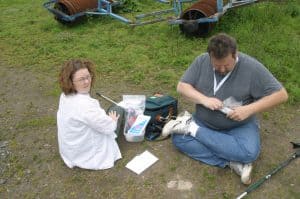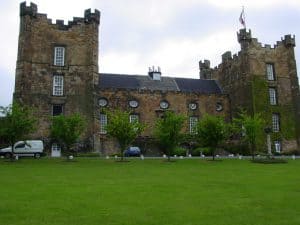 We pulled in Lumley Castle, which is a hotel and it allegedly haunted. It was getting late. We still had time to eat in the restaurant before we retired. True to form, the staff were dressed in medieval garb. The food was good and we were told they were cooked from local recipes dating back centuries.
We pulled in Lumley Castle, which is a hotel and it allegedly haunted. It was getting late. We still had time to eat in the restaurant before we retired. True to form, the staff were dressed in medieval garb. The food was good and we were told they were cooked from local recipes dating back centuries.
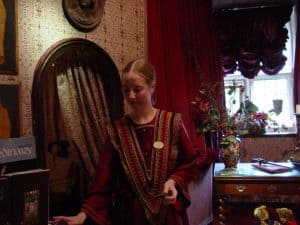
In a common room outside our suites was a snooker table and some of the guests were enjoying it while we watched. It had been a long day and we said our good nights.
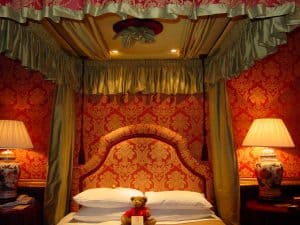 Our rooms were very plush. Poster/canopy beds, fire places, old books and wall coverings. It made one feel….royal-like.
Our rooms were very plush. Poster/canopy beds, fire places, old books and wall coverings. It made one feel….royal-like.
Teresa is a very modest person and even in a room at the height of a castle, she wanted the shades and curtains drawn closed. With both done, it was pitch black with the lights off. Even after 10-15 minutes, it was still pitch black.
Lumley Castle
 Lumley Castle is a 14th-century quadrangular castle at Chester-le-Street in the North of England, near to the city of Durham and a property of the Earl of Scarbrough. It is named for its original creator, Sir Ralph Lumley, who converted his family manor house into a castle in 1389 after returning from wars in Scotland. However, after being implicated in a plot to overthrow Henry IV he was imprisoned and ultimately executed, forfeiting his lands to the Earl of Somerset. In 1421 the ownership of the castle reverted to Sir Ralph Lumley’s grandson, Thomas.
Lumley Castle is a 14th-century quadrangular castle at Chester-le-Street in the North of England, near to the city of Durham and a property of the Earl of Scarbrough. It is named for its original creator, Sir Ralph Lumley, who converted his family manor house into a castle in 1389 after returning from wars in Scotland. However, after being implicated in a plot to overthrow Henry IV he was imprisoned and ultimately executed, forfeiting his lands to the Earl of Somerset. In 1421 the ownership of the castle reverted to Sir Ralph Lumley’s grandson, Thomas.
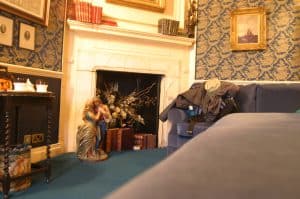 The castle is believed to be one of the most haunted places in County Durham, which includes a story about a woman named Lily Lumley who married Ralph Lumley. In reality, the said Ralph de Lumley, 1st Baron Lumley (c. 1360 – January 1400) was married to Eleanor Neville. But in a tale called The Lily of Lumley he has a previous wife. She was supposedly thrown down a well in the castle grounds by two priests for rejecting the Catholic faith, who then told Baron Lumley she left him to become a nun. Her ghost is said to float up from the well and haunts the castle. A contemporary romance of Medieval times, the tale was based on a legend of a lady of Lumley who was murdered.
The castle is believed to be one of the most haunted places in County Durham, which includes a story about a woman named Lily Lumley who married Ralph Lumley. In reality, the said Ralph de Lumley, 1st Baron Lumley (c. 1360 – January 1400) was married to Eleanor Neville. But in a tale called The Lily of Lumley he has a previous wife. She was supposedly thrown down a well in the castle grounds by two priests for rejecting the Catholic faith, who then told Baron Lumley she left him to become a nun. Her ghost is said to float up from the well and haunts the castle. A contemporary romance of Medieval times, the tale was based on a legend of a lady of Lumley who was murdered.
Sometime in the early morning, something stirred me awake. I rolled over looking and looked at the foot of the bed. Standing there was a woman, She appeared to be well dressed and was facing the fireplace. The room was dimly lit, though I could not tell from where. “I must be dreaming”, I said. She turned towards me, smiled and said something to me in a language I did not understand (though recalling it later, parts of it seemed to have a Latin flavor). She turned more and proceed to walk to the door, and then she was through it. I looked around, Teresa was sound asleep and the glow in the room was fading. I rolled over and went back to sleep.
 In the morning, Teresa had gotten up before me. When I was getting dressed, she ask me if I had gotten up last night and why I had opened the curtains and blinds. I had not. We walked over to the window and I examined the cord which held the blinds up. I was tied to the hook in a knot style I was not familiar with (and I was a Boy Scout). Did the ghost open the window blinds? We may never know.
In the morning, Teresa had gotten up before me. When I was getting dressed, she ask me if I had gotten up last night and why I had opened the curtains and blinds. I had not. We walked over to the window and I examined the cord which held the blinds up. I was tied to the hook in a knot style I was not familiar with (and I was a Boy Scout). Did the ghost open the window blinds? We may never know.
Geocaching
We set out after breakfast. We were still in search of a large cache. We have a travel bug we had picked up in the states. It was a large stuffed toy animal with the geocaching tags and of the caches we had found, none were large enough for him.
Teresa had found a few that were labeled large and one was near a town called Richmond. It was according to the map, near a river bank. We set off time find it.
And we were in luck. The cache was just large enough to hold our little friend and send him on his way. We found a pair of toy car travel bugs who were in a race around the world. We decided to pick on up for a trip to the states.
As we were leaving, we saw the ruins of an old church. Of Course, we had to stop and explore.
Easby Abbey
Easby Abbey or the Abbey of St Agatha is a ruined Premonstratensian abbey on the eastern bank of the River Swale on the outskirts of Richmond in the Richmondshire district of North Yorkshire, England. The site is maintained by English Heritage and can be reached by a riverside walk from Richmond Castle. Within the precinct is the still-active parish church, displaying 13th-century wall paintings.

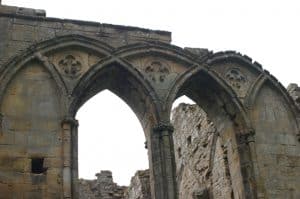
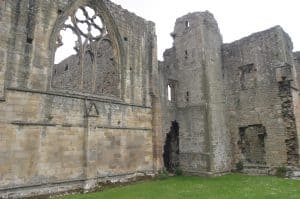
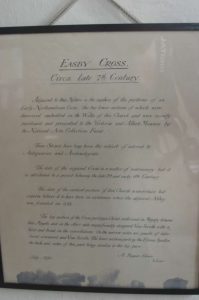


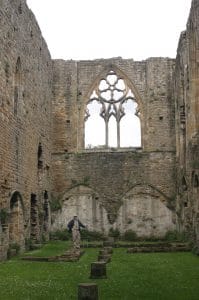
After (too much) time, we had to get back on the road. We needed to get to York and it was a farther drive than most of the legs of this trip.


